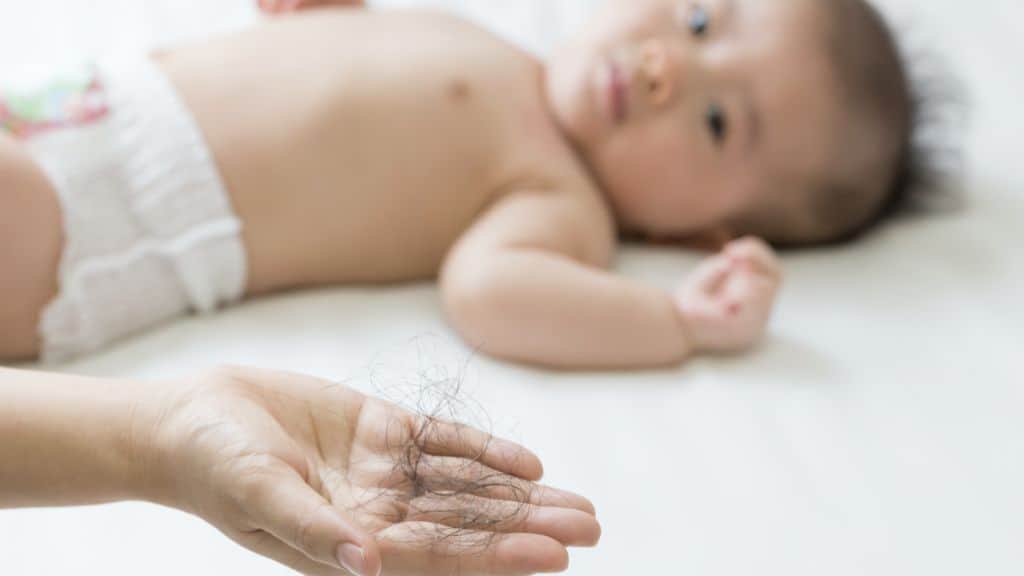
Table of Contents
Your little munchkin must have had a luscious head of hair at birth but have they started to fall out recently? According to the American Academy of Paediatrics (AAP), baby hair loss is completely normal in the first few months of newborn life. Several factors are behind alopecia in babies from sleeping positions to hormonal changes.
The ray of hope – serious hair loss issues in newborns are rare. While every baby has different regrowth patterns, yours will have beautiful trees by their first birthday.
When Do Babies Lose Their Hair?
Most hair loss in babies happens in the first 6 months of their life. It peaks when they are 3 months old. Sometimes hair regrows about the same time it fell but you may not notice that. In other cases, their hair fall is prominent leaving your little one bald. Are they normal? Of course, it is just the old hair falling out to give space to newer hair.
Why Do Babies Lose Their Hair: Causes of Baby Hair Loss
So how do you understand that your baby’s hair is falling out? Do babies lose their hair due to hidden medical issues? Look out for these signs:
- Finding hair in places where your baby rested (like the stroller or the crib)
- Hair in the towel or bath after you have shampooed their hair
- Loose strands of hair in your hand when you are stroking your child’s head
These are common symptoms of hair loss in newborns. Read on to know the causes of hair loss in newborns!
Telogen Effluvium
We are born with all the hair follicles that we’ll ever have in our life. At birth, some of these follicles are still in their resting phase, known as the telogen phase. Follicles enter the next phase called the anagen phase where hair grows out of them. Hair fall is triggered by certain factors that aggravate the telogen phase.
Hormones are yet another cause of baby hair loss. While being pregnant they gave you a supermodel head of hair all the while providing the same for your baby. Once your little one takes birth, they no longer receive these hormones and hence experience hair loss (even your hair falls off once you have delivered the baby).
Stress is another reason behind telogen effluvium because labor and delivery can even lead to PTSD in some people, including your baby.
Friction
Your baby may lose hair when their scalp rubs against hard surfaces like playpens, strollers, and crib mattresses. Experts even recommend making babies lie on their backs to prevent SIDS. So what do you do to prevent this?
This type of baby hair loss is called friction alopecia or neonatal occipital alopecia. However, there is nothing to worry about because by the end of 6 months, in the 7th month when your baby starts rolling over, the thin hairless patches on their head seats get filled up.
Here’s another explanation from a 2011 study about friction alopecia and when does a baby’s hair fall out. It is theorized that baby hair loss is an event starting even before birth. It also confirmed that it occurs in babies
- Whose mothers are younger than 34 years
- Who are delivered full term
- Who are delivered vaginally
Cradle cap
Newborns have harmless, scaly, crusty, and sometimes soil patches on their heads that look like hardened dandruff called cradle caps. Doctors are still unsure of what causes them but hormonal changes or yeast are the main suspects (because they produce more oil on the scalp).
It doesn’t lead to hair loss but when you try to remove them, you could unknowingly take out some of the strands. Mild cases of cradle cap resolve on their own in a few weeks but some may last for months.
Ringworm
Ringworms are a form of fungal infection that leads to infant hair loss along with a scaly, red, ring-like rash on the scalp. It usually doesn’t affect children under the age of two years but it’s highly contagious. One case of ringworm in the house and your newborn could have it via shared things like hair brushes and hats.
Alopecia areata
This is a non-contagious skin condition that gives bald spots on your baby’s head. Alopecia areata is caused by a defective immune system, which means, the immune system attacks and destroys healthy hair cells. A 2002 research noted that it is quite rare in children below 6 months of age but there have been cases reported.
When Does Baby Hair Grow Back After Falling Out: Treatments of Baby Hair Loss
Your newborn’s hair grows back on its own if they have no hidden medical conditions. Check out for medical issues like alopecia areata or ringworm symptoms and get them to a doctor to get treated. By the age of 7 months, babies start rolling over and their hair starts growing back if friction is the main cause of their hair loss.
Sufficient tummy time is enough to bring back their lush hair but remember to put them to sleep on their backs to prevent SIDS. They may roll themselves onto their stomach but it’s okay as long as they roll over to their back.
The Bottom Line: Tips for Preventing Baby Hair Loss
Baby hair loss normally occurs due to friction or change in hormones. Certainly, there are medical issues behind baby hair loss too so have them medically checked and never use any relief methods without consulting first. Whether there’s a little or a lot, here are some tips to groom your baby’s hair:
- Use soft-bristle brushes to comb your little one’s sudsy hair to remove the cradle cap. However, do not battle it because it usually resolves on its own.
- Do not scrub their scalp. Wet a washcloth with shampoo and gently massage.
- You only need to sud up your baby’s scalp twice or thrice a week. Anything more will dry out their scalp.
- Use mild baby shampoo to avoid irritating your newborn’s scalp.
Baby Hair Loss FAQs:
1. How can you stop your baby's hair from falling out?
2. How much hair loss is average for a baby?
3. Do all newborns lose their hair?
4. Why do babies get bald spots?
5. What can you do to stimulate your baby’s hair growth?
Sources:
- https://www.ncbi.nlm.nih.gov/pmc/articles/PMC3162256/
- https://www.amazon.in/Caring-Your-Baby-Young-Child/dp/1984817701
- https://www.ncbi.nlm.nih.gov/pubmed/11994183
- https://www.ncbi.nlm.nih.gov/pmc/articles/PMC3162256/
- https://www.ncbi.nlm.nih.gov/pmc/articles/PMC3999647/
- https://www.ncbi.nlm.nih.gov/pmc/articles/PMC4606321/#:~:text=Telogen%20effluvium%20is%20the%20most,it%20persists%20beyond%206%20months.
- https://www.ncbi.nlm.nih.gov/books/NBK531463/#:~:text=Cradle%20cap%2C%20or%20pityriasis%20capitis,at%203%20months%20of%20life.
- https://www.ncbi.nlm.nih.gov/pmc/articles/PMC3315884/
- https://www.ncbi.nlm.nih.gov/pmc/articles/PMC3519253/
- https://safetosleep.nichd.nih.gov/research/science/causes
Reviewed By :

Nimrat Sidhu - Pediatration
Dr. Nimrat S Sidhu is a practicing pediatrician for about 5 years now and holds an MD pediatrics degree. She was the topper of her batch, has always had a keen interest in her core medical field, and is specially trained for neonatal resuscitation.
She has published multiple research papers on pediatrics and is interested in topics like Neonatal care, skincare, baby growth, vaccination, growth, and development.









